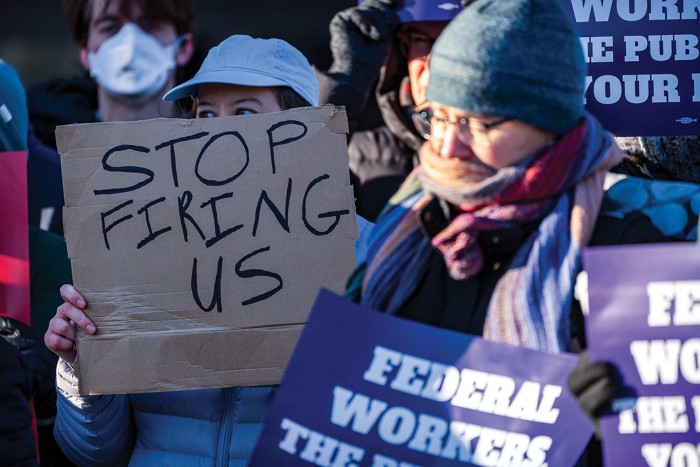Recent U.S. Supreme Court ruling gives President Trump the green light to fire federal employees at will
PIERRE, S.D. – The U.S. Supreme Court has cleared the way for President Donald Trump’s plans to drastically downsize the federal workforce.
At the same time, a separate hiring freeze continues to halt most new federal civilian jobs in South Dakota and across the Northern Plains.
The Court’s July 8 order allows mass layoffs and reorganizations to proceed while legal battles over presidential authority continue, affecting thousands of federal employees in the region.
DOGE’s Government-Wide Cuts
The workforce reductions are part of Trump’s broader effort to “dismantle Government Bureaucracy” through the Department of Government Efficiency (DOGE), initially led by Elon Musk. According to White House executive orders, the administration aims to “restore accountability” by “eliminating waste, bloat, and insularity” across federal agencies.
DOGE has already overseen the firing of tens of thousands of federal employees nationwide, including probationary workers and targeted layoffs at agencies deemed non-essential, according to Associated Press reporting. The effort initially aimed to cut $1 trillion in federal spending, although Musk acknowledged in June that achieving this target would be challenging.
South Dakota’s Federal Footprint
South Dakota had about 11,500 federal civilian employees in May 2025, representing 2.4 percent of all nonfarm jobs in the state, according to the South Dakota Department of Labor and Regulation. This includes workers at agencies ranging from Veterans Affairs medical centers to USDA field offices that serve the state’s agricultural economy.
The Army Corps of Engineers, which manages Missouri River dams and visitor centers, notified 1,068 employees about buyout eligibility in March, according to South Dakota News Watch reporting. Some dam tour operations have been suspended due to staffing reductions.
Two-Pronged Approach: Freeze Then Cut
The administration has implemented a dual strategy. First, a hiring freeze initially imposed on January 20 and extended through July 15, 2025, halts the filling of most vacant civilian positions. Exceptions include national security, immigration enforcement, public safety, and jobs tied to Social Security, Medicare, and veterans’ services, according to White House documents.
Second, under the Supreme Court-approved workforce reduction plans, agencies must develop “large-scale reductions in force” targeting positions not mandated by statute. Once implemented, agencies will hire only one new employee for every four who leave, according to the administration’s “workforce optimization initiative.”
What the Court Decided
The Supreme Court’s July 8 order lifted a lower court injunction that had blocked mass layoff plans at 19 federal agencies. In an unsigned opinion, the Court stated that “the government is likely to succeed on its argument that the executive order and memorandum are lawful,” while emphasizing that “we express no view on the legality of any” agency plans for restructuring.
Justice Ketanji Brown Jackson dissented, warning that the decision demonstrates “enthusiasm for greenlighting this president’s legally dubious actions in an emergency posture”. Justice Sonia Sotomayor joined the majority but wrote separately that “we thus have no occasion to consider whether they can and will be carried out consistent with the constraints of law”.
The decision came after lower courts found that such workforce reorganization typically requires congressional approval, but the administration argued it has executive authority to restructure agencies.
Agency-Specific Impact
The Department of Veterans Affairs, which operates medical facilities in Sioux Falls, Fort Meade, and Hot Springs, initially planned to cut up to 80,000 positions nationwide. VA Secretary Doug Collins announced July 7 that the department would instead cut about 30,000 positions through attrition and voluntary programs, avoiding mass layoffs.
The Agriculture Department faces significant changes that could affect South Dakota’s farm-heavy economy. White House budget documents obtained by Government Executive reveal plans to consolidate local USDA county offices into state committees, potentially leading to the closure of field offices that provide farm loans and conservation services.
At the Education Department, nearly half the workforce faces elimination through reductions in force, according to NPR reporting. The agency began placing affected employees on administrative leave in March.

*Source: South Dakota Department of Labor and Regulation
Local Political Response
South Dakota’s congressional delegation has offered measured responses to the cuts. Representative Dusty Johnson defended the workforce reductions as “needed disruptions” during a February chamber of commerce event, calling them “very standard HR disruptions in the private sector,” according to South Dakota Searchlight reporting.
However, Johnson acknowledged “there are methods that can be improved” and said he has discussed implementation concerns with the administration. Senate Majority Leader John Thune told CNN that while DOGE’s “objectives” are “right,” agency leaders are “probably better attuned to the individual programs”.
Northern Plains News could find no public comments from the South Dakota delegation or Gov. Larry Rhoden about the Supreme Court decision.
Timeline and Next Steps
Federal agencies submitted their initial reorganization plans by March 13, followed by detailed Phase 2 plans by April 14, according to OMB and OPM requirements. These plans included organizational charts, employee data, and timelines for implementing workforce reductions by September 30, the end of the fiscal year.
Some agencies have begun implementing their plans. HHS started its reduction-in-force on April 1, while the Department of Transportation’s Inspector General submitted its Phase 2 plan as required. However, many agency cuts remain blocked by federal court injunctions, despite the Supreme Court’s decision on July 8.
The administration has reopened “deferred resignation” programs, allowing federal employees to quit while receiving pay through September 30, encouraging voluntary departures over forced layoffs.
Bottom Line
South Dakota faces the prospect of significantly reduced federal employment affecting everything from agricultural services to veterans’ health care.. While the administration frames the cuts as necessary efficiency measures, the full impact on rural communities heavily dependent on federal services remains to be seen as agencies implement their reduction plans throughout 2025.


